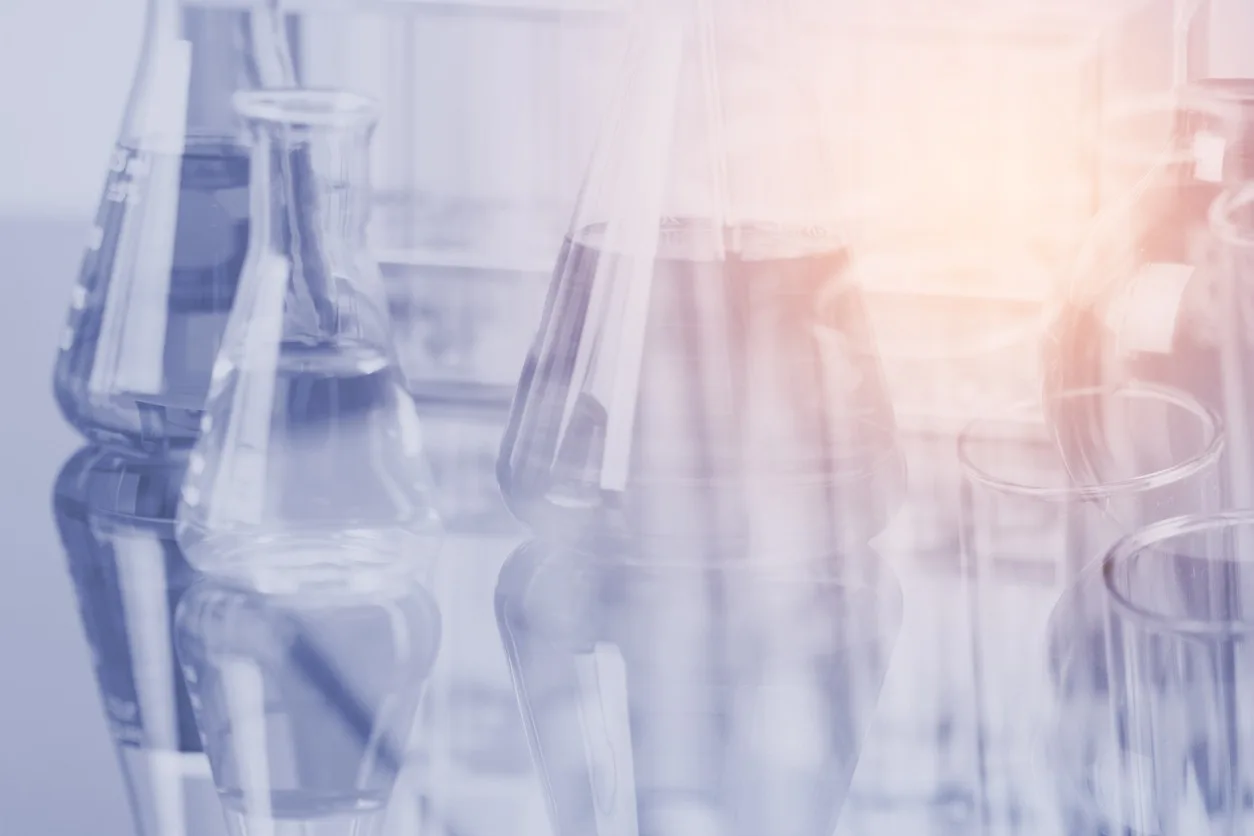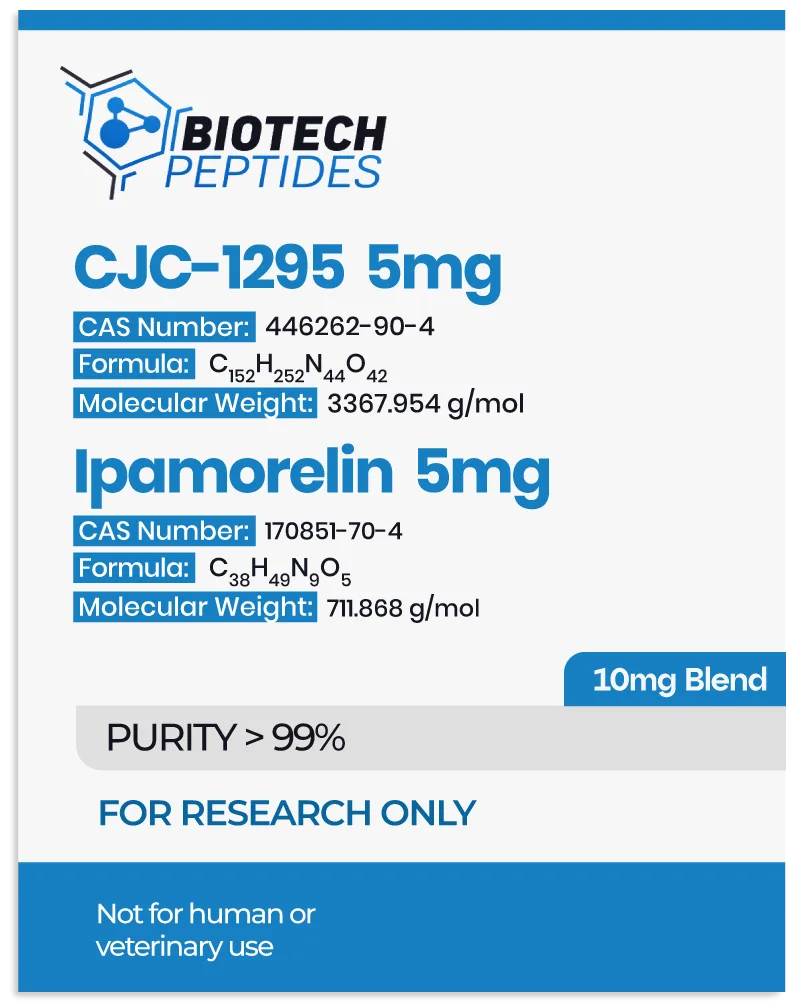Both Ipamorelin and CJC-1295 peptides are grouped within this category, investigated for their supposed similar physiological effects, although they appear to differ primarily in their half-life and pharmacokinetic properties.
CJC-1295 Peptide
CJC-1295 peptide represents a tetra-substituted derivative of growth hormone-releasing hormone (GHRH) 1-29, devised to mimic the shortest functional sequence of GHRH. GHRH 1-29 encompasses the initial 29 amino acids of the native GHRH peptide and holds the potential to stimulate growth hormone production within somatotrophs, the pituitary gland cells. The peptide undergoes four amino acid substitutions, strategically positioned within its structure, which researchers hypothesize may bolster its activity and resilience against proteolytic degradation. Specifically, the substitutions are situated at the 2nd, 8th, 15th, and 27th amino acid positions.
These alterations potentially enable the peptide to covalently bind to blood albumin, with incidental interactions possibly occurring with fibrinogen and immunoglobulin G (IgG). Consequently, the reported half-life of the peptide may possibly extend from 10 minutes to approximately 30 minutes.[3] This elongated half-life may culminate in heightened levels of plasma growth hormone and insulin-like growth factor 1 (IGF-1).
Furthermore, CJC-1295 is speculated to incorporate a “drug affinity complex” (DAC) component, which may associate with plasma proteins. Specifically, the DAC element within CJC-1295 pertains to the attachment of N-epsilon-3-maleimidopropionamide derivative of lysine at the C-terminal end. By amalgamating the tetra-substituted amino acid chain with the DAC element, CJC-1295 may exhibit improved pharmacokinetic properties while preserving a comparable affinity to the GHRH receptors within the pituitary gland, akin to endogenous GHRH.[4]
Ipamorelin Peptide
Ipamorelin is a synthetically engineered pentapeptide believed to interact with the growth hormone secretagogues receptor (GHS-R1a) situated in pituitary gland cells. These receptors, primarily localized in the hypothalamus, are commonly referred to as ghrelin receptors due to the apparent affinity of ghrelin as their primary endogenous ligand. Ipamorelin distinguishes itself among other growth hormone secretagogues (GHSs) as a potentially more selective compound. It is hypothesized to selectively stimulate the release of growth hormone (GH) levels from somatotroph cells without concomitant elevation of other hormones produced by the anterior pituitary gland, such as prolactin.
When the peptide blend, also denoted as the peptide stack, is introduced in combination, studies indicate that Ipamorelin typically initiates first action, purported exhibiting discernible impact within the initial two hours of exposure. Subsequently, as the Ipamorelin effect diminishes, the CJC-1295 peptide may progressively contribute to the alleged physiological actions.[5]
CJC-1295 & Ipamorelin Peptide Blend and Growth Hormone Levels
In a clinical trial[6] conducted in the early 2000s, research subjects were allocated into two groups: one receiving a placebo and the other exposed to CJC-1295 peptide. Blood samples taken before and after the peptide exposure revealed a substantial increase, approximately 7.5-fold, in growth hormone pulsatility levels in the CJC-1295 group compared to the placebo group. Additionally, beyond its apparent influence on growth hormone synthesis, CJC-1295 reportedly “caused an increase in total pituitary RNA and GH mRNA, suggesting that proliferation of somatotroph cells had occurred, as [noted] by immunohistochemistry images.”
The underlying mechanisms of CJC-1295’s potential reportedly involve its interaction with specific binding sites on the growth hormone-releasing hormone (GHRH) receptor protein, possibly triggering conformational changes and initiating intracellular signaling cascades.[7] This interaction is speculated to activate G-proteins, which, in turn, may lead to the generation of secondary messengers like cyclic adenosine monophosphate (cAMP) or inositol trisphosphate (IP3). These messengers further modulate cellular activities through protein kinases, ultimately influencing gene expression associated with growth hormone production.
Conversely, researchers suggest that Ipamorelin interacts with the N-terminus of the growth hormone secretagogue receptor (GHS-R1a) in anterior pituitary gland cells, forming non-permanent attachments through intermolecular forces such as hydrogen bonds and van der Waals forces. This interaction may potentially induce conformational changes in the receptor, initiating cell signaling pathways primarily involving G-proteins, notably Gαq/11.[8] Activation of GHS-R1a may potentially trigger the activation of phospholipase C (PLC), leading to the production of secondary messengers like IP3 and diacylglycerol (DAG). IP3 release may lead to calcium ion (Ca2+) release from the endoplasmic reticulum, while DAG activates protein kinase C (PKC), ultimately facilitating the release of growth hormone from pituitary gland cells.[9]
These findings suggest the intricate molecular mechanisms through which CJC-1295 and Ipamorelin may potentially modulate growth hormone secretion, providing valuable insights into their possible physiological effects.
Comparative Mechanisms of Action
Research investigations have been undertaken to ascertain the half-life and individual mechanistic actions of the two peptides – Ipamorelin and CJC-1295.
In a 1990s study[5] with a concentration-escalation design, the levels of growth hormones were systematically monitored following each presentation of the peptides. The study’s findings suggested a singular episode of growth hormone release, reaching its zenith at 0.67 hours, followed by an exponential decline, supposedly due to negligible concentrations. This investigation concluded that Ipamorelin appears to exhibit a short half-life of approximately 2 hours, with potential actions tapering off thereafter.
In contrast, CJC-1295 was suggested to host a notably protracted half-life. Researchers noted that a single introduction of the peptide appeared to have led to sustained upregulation of growth hormone production by somatotrophs, purportedly contributing to an overall increase in growth hormone secretion by 46%. Another publication reported potential increases in growth hormone concentrations by “2- to 10-fold” and estimated the half-life of CJC-1295 to range between 5.8 to 8.1 days.[11]
Ipamorelin & CJC-1295 Peptide Blend and Lean Mass
The interaction between CJC-1295 and Ipamorelin in stimulating growth hormone production by somatotroph cells in the anterior pituitary gland appears to yield a synergistic effect, potentially resulting in a positive nitrogen balance and increased lean mass in experimental models. A study[11] aimed to elucidate the metabolic potential of Ipamorelin focused on hepatic markers associated with alpha-amino-nitrogen processing during artificially-induced catabolism.
Researchers investigated the liver’s capacity to produce urea-N (CUNS), serving as an indicator of nitrogen processing within the organ. They assessed the mRNA levels associated with enzymes of the urea cycle, evaluated overall nitrogen equilibrium, and estimated nitrogen distribution across various organs. Ipamorelin exposure was hypothesized to lead to a notable 20% reduction in CUNS compared to the catabolic state induced experimentally. Additionally, it was suggested that Ipamorelin might decrease the expression of urea cycle enzymes, restore nitrogen equilibrium, and potentially modulate nitrogen levels in organs.
Disclaimer: The products mentioned are not intended for human or animal consumption. Research chemicals are intended solely for laboratory experimentation and/or in-vitro testing. Bodily introduction of any sort is strictly prohibited by law. All purchases are limited to licensed researchers and/or qualified professionals. All information shared in this article is for educational purposes only.
References:
- Raun K, Hansen BS, Johansen NL, Thøgersen H, Madsen K, Ankersen M, Andersen PH. Ipamorelin, the first selective growth hormone secretagogue. Eur J Endocrinol. 1998 Nov;139(5):552-61. doi: 10.1530/eje.0.1390552. PMID: 9849822. https://pubmed.ncbi.nlm.nih.gov/9849822/
- Lucie Jette et al, hGRF1-29-Albumin Bioconjugates Activate the GRF Receptor on the Anterior Pituitary in Rats: Identification of CJC-1295 as a Long Lasting GRF Analog, ResearchGate, January 2005.
- The Discovery of Growth Hormone-Releasing Hormone: An Update https://onlinelibrary.wiley.com/doi/full/10.1111/j.1365-2826.2008.01740.x
- Jetté, L., Léger, R., Thibaudeau, K., Benquet, C., Robitaille, M., Pellerin, I., Paradis, V., van Wyk, P., Pham, K., & Bridon, D. P. (2005). Human growth hormone-releasing factor (hGRF)1-29-albumin bioconjugates activate the GRF receptor on the anterior pituitary in rats: identification of CJC-1295 as a long-lasting GRF analog. Endocrinology, 146(7), 3052–3058. https://doi.org/10.1210/en.2004-1286
- Gobburu JV, Agersø H, Jusko WJ, Ynddal L. Pharmacokinetic-pharmacodynamic modeling of ipamorelin, a growth hormone releasing peptide, in human volunteers. Pharm Res. 1999 Sep;16(9):1412-6. doi: 10.1023/a:1018955126402. PMID: 10496658. https://pubmed.ncbi.nlm.nih.gov/10496658/
- Ionescu M, Frohman LA. Pulsatile secretion of growth hormone (GH) persists during continuous stimulation by CJC-1295, a long-acting GH-releasing hormone analog. J Clin Endocrinol Metab. 2006 Dec;91(12):4792-7. doi: 10.1210/jc.2006-1702. Epub 2006 Oct 3. PMID: 17018654. https://pubmed.ncbi.nlm.nih.gov/17018654/
- Martin, B., Lopez de Maturana, R., Brenneman, R., Walent, T., Mattson, M. P., & Maudsley, S. (2005). Class II G protein-coupled receptors and their ligands in neuronal function and protection. Neuromolecular medicine, 7(1-2), 3–36. https://doi.org/10.1385/nmm:7:1-2:003
- Yin, Y., Li, Y., & Zhang, W. (2014). The growth hormone secretagogue receptor: its intracellular signaling and regulation. International journal of molecular sciences, 15(3), 4837–4855. https://doi.org/10.3390/ijms15034837
- Bill, C. A., & Vines, C. M. (2020). Phospholipase C. Advances in experimental medicine and biology, 1131, 215–242. https://doi.org/10.1007/978-3-030-12457-1_9
- Martin, B., Lopez de Maturana, R., Brenneman, R., Walent, T., Mattson, M. P., & Maudsley, S. (2005). Class II G protein-coupled receptors and their ligands in neuronal function and protection. Neuromolecular medicine, 7(1-2), 3–36. https://doi.org/10.1385/nmm:7:1-2:003
- Aagaard, N. K., Grøfte, T., Greisen, J., Malmlöf, K., Johansen, P. B., Grønbaek, H., Ørskov, H., Tygstrup, N., & Vilstrup, H. (2009). Growth hormone and growth hormone secretagogue effects on nitrogen balance and urea synthesis in steroid treated rats. Growth hormone & IGF research : official journal of the Growth Hormone Research Society and the International IGF Research Society, 19(5), 426–431. https://doi.org/10.1016/j.ghir.2009.01.001







